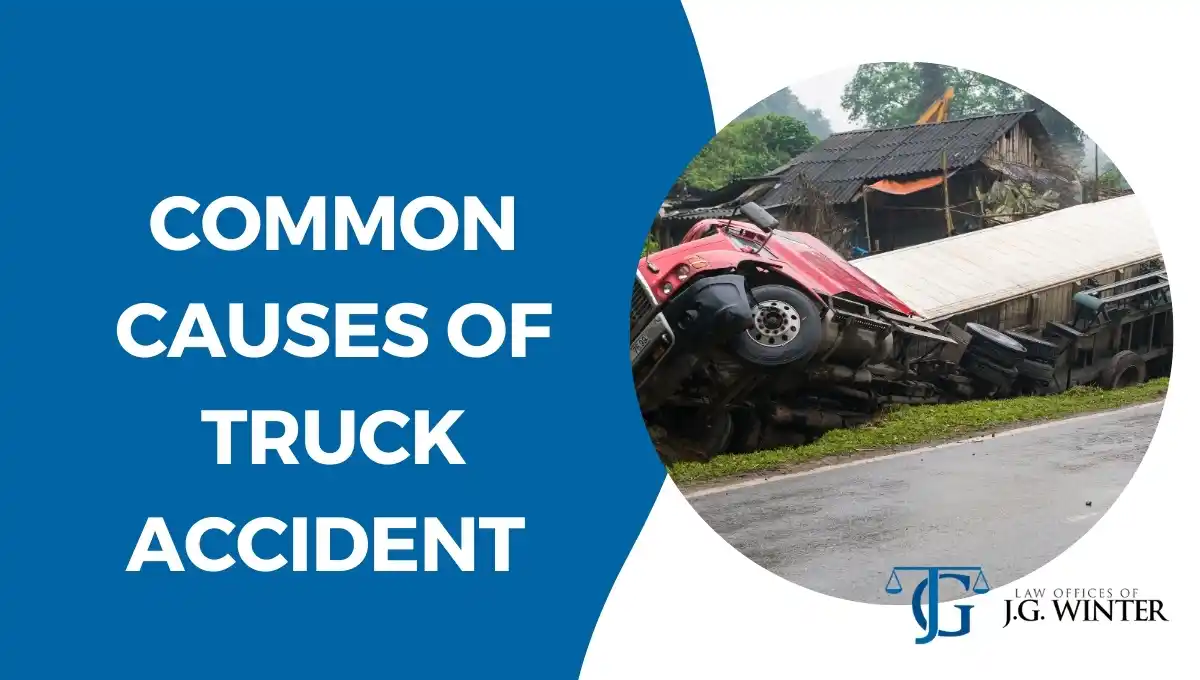Understanding the common causes of truck accidents is of utmost importance. These major incidents almost always have a significant negative impact on road safety, typically causing severe injuries, possible fatalities and substantial property damage. Recent statistics from 2022 indicate that large trucks were involved in nearly 5,600 fatal crashes, resulting in over 5,700 deaths, according to the National Highway Traffic Safety Administration (NHTSA), underscoring the urgency for awareness and action. Truck accident causes vary widely, but some of the most frequent contributors include driver-related factors, mechanical failures and adverse environmental conditions. The Federal Motor Carrier Safety Administration (FMCSA) reports that driver error is a primary factor in an overwhelming 87% of truck crashes. Mechanical issues also account for a significant portion, with brake problems contributing to 29% of large truck accidents.
By knowing what causes these accidents, you can take steps to prevent them. Whether you’re a driver, a victim or simply a concerned citizen interested in maximizing road safety, this guide is here to help you.
Understanding driver-related cause
When it comes to truck accidents, drivers’ decisions and behaviors play a pivotal role. Understanding these factors sheds light on the human element in vehicular accidents, highlighting both the challenges and opportunities for prevention. It’s crucial to consider truck driver safety tips and DUI/DWI laws for truckers to ensure safer roads.
1. Distracted driving
Distracted driving is any activity that diverts a driver’s attention away from the primary task of driving, potentially endangering the driver, passengers and others on the road.
Types of distractions and their impacts
- Visual Distractions: Taking eyes off the road to look at a phone, GPS other passengers or external objects increases the risk of missing critical road hazards and traffic signals.
- Manual Distractions: Actions that require removing hands from the steering wheel, such as texting, eating, adjusting controls or talking to others reduce the driver’s ability to respond quickly to changing road conditions.
- Cognitive Distractions: Mental distractions like daydreaming, engaging in intense conversations or being emotionally upset can impair decision-making and reaction times.
Prevention strategies to mitigate risks
- Use of Technology: Enable hands-free features for calls and navigation or use voice commands to minimize manual distractions.
- Set Boundaries: Establish and firmly adhere to rules to avoid distractions, such as not using phones while driving and pulling over to handle urgent matters.
- Educational Campaigns: Promote awareness through campaigns that emphasize the dangers of distracted driving and encourage responsible habits.
- Legislation and Enforcement: Support and enforce laws prohibiting texting and handheld device use while driving, ensuring compliance for safer roads.
2. Driver fatigue
Driver fatigue refers to feeling tired, exhausted, or sleepy while operating a vehicle. It significantly impairs driving abilities and increases the risk of accidents.
Causes and how it impairs driving abilities
Driver fatigue can stem from various factors, including:
- Lack of Adequate Sleep: Not getting enough restorative sleep can lead to drowsiness and reduced alertness, making one feel drowsy.
- Long Hours of Driving: Extended periods behind the wheel without breaks can increase exhaustion levels, leading to driver fatigue that severely impairs focus.
- Time of Day: Driving during late night or early morning hours, when the body’s natural sleep rhythms are at their lowest, can also exacerbate driver fatigue.
Preventive measures
To reduce the risks associated with driver fatigue, consider the following preventive measures:
- Take Regular Breaks: Schedule breaks every two hours or 100 miles to rest and refresh, reducing the likelihood of driving drowsy.
- Plan Ahead: Avoid long drives during hours when you normally fall asleep to prevent driver fatigue.
- Stay Hydrated and Nourished: Drink water and eat light, healthy snacks to maintain energy levels and combat driver fatigue. If you do not have refreshments in your car, map out a route based on your available fuel that includes timely stops at restaurants and gas stations.
- Use Alertness Techniques: If feeling drowsy, engage in activities like listening to lively music, drinking caffeinated beverages or talking with a passenger to stay alert and avoid driving drowsy.
3. Speeding
Speeding is the act of driving above the posted speed limit, and it is a common cause of road accidents and traffic violations. It significantly increases the risk of collisions and reduces the driver’s ability to react to unexpected situations.
Reasons behind speeding
Speeding occurs due to various reasons, including:
- Impatience and Rush: Drivers often exceed speed limits due to impatience or rushing to reach their destination quickly, despite knowing the risks.
- Traffic Flow: Following the flow of traffic or feeling pressured to match the speed of other vehicles can lead to speeding.
- Perception of Safety: Some drivers mistakenly believe they can handle higher speeds or perceive certain roads as safe for speeding.
Potential consequences
Speeding can lead to severe consequences, such as:
- Increased Risk of Accidents: Higher speeds reduce reaction times and increase the likelihood of collisions, contributing to the causes of road accidents.
- Severity of Injuries: Accidents at high speeds often result in more severe injuries or fatalities due to the force of impact.
- Legal Ramifications: Speeding tickets, hefty fines and potential license suspensions can result from violating speed limits and speed limit enforcement.
4. Substance abuse
Substance abuse, including alcohol and drugs, significantly impairs driver abilities and poses grave risks to all who share the road.
Alcohol, prescription, and illegal drug impairments
Substance abuse significantly impairs driver abilities in various ways:
- Alcohol: Impairs coordination, reaction time and decision-making, increasing the risk of accidents.
- Prescription Drugs: Some medications can cause drowsiness, dizziness or other side effects that impair driving performance.
- Illegal Drugs: Narcotics, stimulants and other illicit substances can distort perception and judgment, posing serious risks on the road.
Legal implications and prevention
The legal implications of driving under the influence of alcohol or drugs include:
- Legal Penalties: DUI/DWI charges, fines, license suspension and potential imprisonment for substance abuse violations.
- Preventive Measures: Education on the dangers of driving under the influence and promoting alternative transportation options to deter impaired driving.
5. Reckless and aggressive driving
Reckless and aggressive driving encompasses behaviors on the road that endanger others’ safety and violate traffic laws.
Examples and behavioral patterns
These examples and behavioral patterns illustrate the distinctions between aggressive and reckless driving, emphasizing their dangers and legal repercussions including penalties and safety concerns.
Aggressive Driving Behaviors:
- Tailgating: Following another vehicle too closely, often to intimidate the driver ahead.
- Excessive Speeding: Driving well above the posted speed limit or too fast for conditions.
- Sudden Maneuvers: Abrupt lane changes without signaling or cutting off other drivers aggressively.
- Verbal or Physical Aggression: Engaging in confrontational behavior like shouting, honking excessively or using gestures, which is known in common vernacular as “road rage.”
Behavioral Patterns of Reckless Driving:
- Running Red Lights: Ignoring traffic signals and proceeding through intersections illegally.
- Street Racing: Participating in unauthorized speed competitions on public roads.
- Driving Under the Influence (DUI/DWI): Operating a vehicle while impaired by alcohol or drugs.
- Distracted Driving: Texting, phone use or engaging in activities that divert attention from driving.
6. Inexperienced drivers
Inexperienced drivers need more time behind the wheel to learn how to make good decisions. They are often young, new to driving or in need of better and/or more formal training. This lack of expertise can pose significant challenges on the road, impacting both the drivers and others around them.
Challenges of inexperienced drivers
- Lack of Road Awareness: Inexperienced drivers may need help understanding traffic patterns and road signs and anticipating the actions of other drivers, leading to hesitations or errors in judgment.
- Limited Decision-Making Skills: They may still need to develop the ability to make quick, effective decisions in unexpected situations, which can increase the likelihood of accidents.
- Difficulty Handling Stressful Situations: New drivers may find it challenging to remain calm under pressure in stressful situations such as navigating busy intersections or adverse weather conditions, which can escalate risks on the road.
Risks of inadequate training
- Increased Accident Rates: Drivers with inadequate training are more likely to be involved in accidents due to their lack of skills in hazard recognition and defensive driving techniques.
- Non-compliance with Traffic Laws: Poorly trained drivers may unintentionally or knowingly violate traffic laws, unaware of the potential consequences or risks they pose to themselves and others.
- Lack of Emergency Response Preparedness: With proper training, drivers may react appropriately in emergencies, such as sudden braking or avoiding obstacles on the road.
Mechanical and equipment failures
Mechanical integrity and proper maintenance of equipment, which are paramount to preserve vehicle and driver safety, are directly affected by poor maintenance practices and equipment failures.
7. Vehicle maintenance issues
Proper vehicle maintenance is a mandatory component for ensuring safety and reliability on the road.
Common mechanical failures
Regular mechanical inspections are essential to identify and address potential issues before they escalate. Common mechanical failures include:
- Brake System Malfunctions: Insufficient brake fluid, worn brake pads or brake caliper issues can compromise braking efficiency, posing serious safety risks.
- Engine Problems: Issues like overheating due to coolant leaks, worn-out spark plugs or malfunctioning sensors can lead to engine breakdowns, causing vehicle malfunctions and stalls.
- Transmission Issues: Fluid leaks, clutch wear or slippage can impair gear shifting and overall drivability, necessitating timely repairs.
Importance of regular maintenance
Regular maintenance routines are critical for preventing these issues and ensuring vehicle reliability:
- Mechanical Inspection Routines: Implementing scheduled inspections for brakes, engine components and transmission systems helps detect and resolve potential failures early on before they lead to acidents..
- Tire Maintenance for Trucks: Proper tire care, including checking tire pressure, tread depth and alignment, is vital. This reduces the risk of blowouts and ensures optimal vehicle handling and stability
8. Improperly loaded cargo
Improperly loaded cargo poses significant risks on the road, such as the dangers of overloading and its effects on vehicle stability, visibility and steering.
Risks of overloading
Overloading a vehicle beyond its designed capacity can lead to various hazards:
- Mechanical Strain: Excessive weight strains the vehicle’s suspension, tires, and braking systems accelerating wear and potential failure.
- Reduced Maneuverability: Overloaded vehicles are harder to maneuver, especially in emergencies or adverse weather conditions.
- Increased Stopping Distance: Heavy loads require longer braking distances, compromising the vehicle’s ability to stop promptly.
Effects on vehicle stability
Improperly loaded cargo affects vehicle stability in several ways:
- Tipping Risk: Unevenly distributed or overweight cargo increases the risk of the vehicle tipping over, especially during turns or sudden maneuvers.
- Loss of Control: Overloaded vehicles are prone to swaying and losing steering control, endangering drivers and other road users.
- Compromised Safety: Cargo that shifts or falls due to improper securing can cause accidents or obstructions.
9. Critical equipment failures
Critical equipment failures, such as brake failures and tire blowouts, pose serious risks on the road.
Brake failures
Brake failures are among the most critical issues that can compromise vehicle safety:
Causes: Insufficient brake fluid, worn brake pads or brake line leaks can lead to brake failure.
Prevention: Regular brake system inspections are essential, including checks on fluid levels and pad wear. Following manufacturer-recommended brake system requirements and replacing worn components promptly can prevent failures.
Tire blowouts
Tire blowouts can occur unexpectedly, affecting vehicle control and safety:
Causes: Overinflated or underinflated tires, worn-out treads or hitting road debris can lead to blowouts.
Prevention: Regularly checking tire pressure, tread depth and exterior surface condition of tires is crucial. Following tire maintenance guidelines and replacing tires before they become excessively worn reduces the risk of blowouts.
Environmental and external factors
External factors such as adverse weather conditions and road surface damage significantly impact driving safety and accident rates. Drivers should follow driving tips for adverse weather to ensure safety. Understanding road conditions and adapting driving behavior is crucial for preventing accidents in challenging weather conditions.
10. Adverse weather conditions
Driving through adverse weather requires careful consideration and adherence to safety measures to ensure a safe journey. Here are several detailed driving tips for handling bad weather conditions, incorporating keywords like traffic safety measures.
Driving challenges in adverse weather
Adverse weather presents several challenges for drivers:
- Reduced Visibility: Rain, fog, or snow can severely impair driver visibility, making it difficult to see other vehicles, pedestrians or road signs.
- Reduced Traction: Wet or icy roads decrease tire grip, increasing the risk of skidding or hydroplaning.
- Unpredictable Conditions: Sudden wind gusts or changing weather patterns can catch drivers off guard.
Safety tips for driving in bad weather
To drive safely in bad weather, drivers should follow these traffic safety measures:
- Reduce Speed: Slow down to maintain control and allow for increased stopping distances.
- Increase Following Distance: Keep a safe distance from the vehicle ahead to account for reduced visibility and sudden stops.
- Use Headlights: Turn on headlights or fog lights to improve visibility, even during daytime fog or heavy rain.
- Avoid Distractions: Focus solely on driving and avoid distractions like cell phones or adjusting music.
Legal and liability considerations
Truck accidents often result in complex legal scenarios where determining liability and seeking compensation are difficult and convoluted multi-step processes. Key legal aspects include:
- Liability Determination: Establishing who is responsible for the accident involves examining factors such as driver negligence, trucking company policies, vehicle maintenance records and adherence to prevailing traffic laws.
- Legal Rights: Victims of truck accidents have legal rights to pursue compensation for damages, including medical expenses, lost wages, property damage and pain and suffering.
- Insurance Claims: Dealing with insurance companies can be challenging. Understanding insurance policies and negotiating fair settlements require legal expertise to ensure adequate compensation.
- Legal Process: The legal process for truck accident cases involves claims filing, discovery, negotiations and possibly litigation if settlements are not reached. Timely action is crucial due to statute of limitations constraints.
- Role of Legal Representation: Hiring an experienced truck accident lawyer is essential. They advocate for victims’ rights, handle legal complexities, gather evidence, negotiate with insurance companies and represent clients in court if necessary.
Driver vs. company liability
Understanding liability in truck accidents is essential, particularly when distinguishing between driver and company responsibilities.
Driver Liability
Drivers can be held liable for accidents due to:
- Negligence: Speeding, distracted driving or driving under the influence.
- Violation of Traffic Laws: Ignoring signals, improper lane changes or failure to yield.
- Driver Fatigue: Exceeding hours of service limits mandated by federal, local and industry-specific regulations.
Company Liability
Trucking companies may be responsible for accidents due to the following:
- Negligent Hiring: Hiring drivers without proper qualifications or safety records.
- Inadequate Training: Failing to train drivers on safety protocols or regulatory compliance.
- Maintenance Failures: Neglecting vehicle inspections, repairs or compliance with maintenance schedules.
- Pressure for Delivery: Imposing unrealistic schedules that encourage speeding or fatigue.
Importance of understanding truck regulations
Compliance with trucking regulations is vital for safety and legal reasons. It is important to understand and follow truck regulations.
Safety and Compliance
Truck regulations are designed to:
- Ensure Safety: By mandating driver qualifications, vehicle maintenance standards and limits on driving hours.
- Protect Others: Regulations aim to minimize risks to other motorists and pedestrians on the road.
Legal Implications
Understanding truck regulations helps in:
- Liability Determination: Compliance or non-compliance with regulations can influence liability in accidents.
- Insurance Claims: Compliance may affect insurance coverage and claims settlements.
For personalized advice on truck accident liability and understanding legal regulations, consult a truck accident lawyer today.
Conclusion
Understanding the common causes of truck accidents is vital for road safety. By being aware of factors such as distracted driving, driver fatigue, speeding and vehicle maintenance issues,, individuals can make informed decisions and take lower-risk precautions to prevent accidents. Implementing preventive measures, promoting awareness and adhering to safety guidelines are necessary steps towards reducing truck accidents and ensuring safer roads for everyone.
If you’ve been affected by a truck accident, don’t wait. Contact us today for expert legal advice and support tailored to your situation.

Common causes of truck accident: FAQs
Why is driver fatigue a significant factor in truck accidents?
Driver fatigue is a significant factor in truck accidents because it reduces alertness and reaction time, increasing the likelihood of accidents. Long hours on the road without adequate rest can lead to drowsiness, impaired judgment and even falling asleep at the wheel.
How can distracted driving accidents involving trucks be prevented?
Distracted driving accidents can be prevented by implementing strict policies against using mobile devices while driving, encouraging drivers to take regular breaks and promoting awareness of the dangers of distracted driving through training programs.
Why is speeding a prevalent factor in truck accidents?
Speeding is prevalent because it reduces the driver’s ability to react to sudden changes on the road and increases the stopping distance required. Due to their size and weight, trucks need more time to slow down or stop, making speeding particularly dangerous.
How do adverse weather conditions contribute to truck accidents?
Adverse weather conditions like rain, snow and fog reduce visibility and traction, making it harder for drivers to control their vehicles. These conditions can lead to skidding, longer stopping distances loss of vehicle control and increased risk of collisions.
Why are mechanical failures a substantial factor in truck accidents?
Mechanical failures such as brake malfunctions, tire blowouts and steering issues can lead to loss of vehicle control. Regular maintenance and timely repairs are essential to reduce the likelihood of such failures and ensure the safety of the truck driver and other road users.
How does inadequate training contribute to truck accidents?
Inadequate training renders drivers unprepared to handle the complexities and higher risks of operating large commercial vehicles. Proper training ensures drivers understand safety protocols, can maneuver their truck cab and trailer capably, and can respond quickly to address various road conditions, reducing the risk of accidents.


